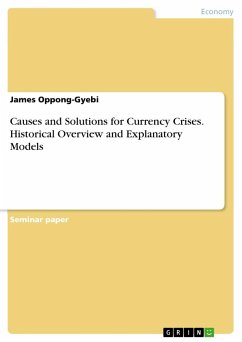Seminar paper from the year 2021 in the subject Economics - Monetary theory and policy, grade: 2.3, University of Siegen (Faculty 3: School of Economic Discipline), language: English, abstract: In recent years, several currency crises were recorded. These include the currency crises of Latin America (1995), East Asia (1997), Russia (1998), Zimbabwe (2000), Turkey (2018), and currently Lebanon and Venezuela. Why have some currencies failed or crashed throughout history? And are there models/theories to explain why these crises occur? This paper, therefore, seeks to primarily discuss the general and some possible reasons behind the occurrence of currency crises. The paper also looks at the possible outcomes and effects of currency crises as well as measures that can be taken to address them. It discusses further some known examples of currency crises and the features they have in common. The rest of the paper is structured as follows: Section 2: Definition of currency crises; Section 3: The general theories of currency crises; Section 4: Examples of some historic currency crises; Section 5: Possible or potential causes of currency crises; Section 6: The outcomes and costs of currency crises; Section 7: Early warning systems and indicators of a currency crisis; Section 8: Measures to mitigate or prevent a currency crisis; and Section 9: Conclusion.
Hinweis: Dieser Artikel kann nur an eine deutsche Lieferadresse ausgeliefert werden.
Hinweis: Dieser Artikel kann nur an eine deutsche Lieferadresse ausgeliefert werden.








